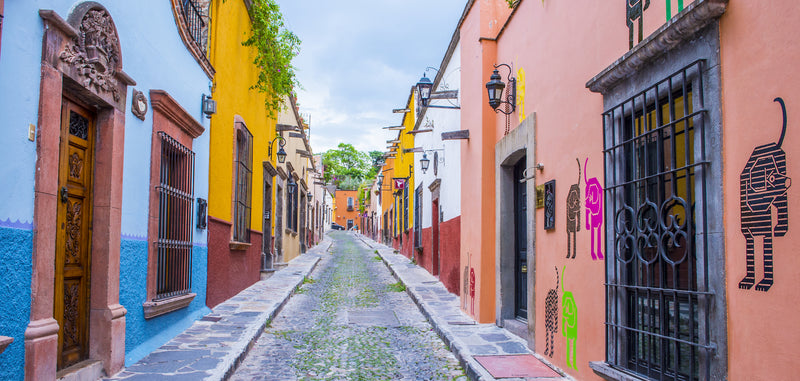Cosmic Designs: the duality, sacred mountain & four-petal flower
When we look into prehispanic textile designs we find similar patterns and drawings. So what is the meaning behind them? They all relate to principles about the cosmic birth and balance of life.
The duality principle
At the beginning of the world, there was a point.
Then, the axis mundi arised. That primordial vertical axis and generator of the Cosmos was governed by the dual principle of the opposing forces: water and fire, heat and cold, day and night, male and female, life and death, the earth and the sky, the eagle and the jaguar, the eagle and the cactus... The ancient Mexicans captured that cosmic yin yang through a large panel of representations, in simple or sophisticated ways. As you see in the picture below, the "xicalcoliuhqui" sign shows a stepped fret with a “positive” and “negative” design. Precious materials such as jaguar skin and feathers reinforce the opposing forces. The “malinalli” sign with two twisted branches represents the descendant celestial fire and ascendant aquatic streams.

The duality principle governs all things, all cycles from the smallest to the largest one. As the day follows the night, dry season follows rainy season, the east-west sun journey in the sky follows the nocturnal sun journey from west to east in the underworld.
As everything is dual, war is “in atl, in tlachinolli” in nahuatl language, that means “the water, the fire”. Military orders are “in ocelotl, in cuauhtli”, “the jaguar, the eagle”. The concept of origin is “in matlalac, in tozpalac”, “the blue water, the yellow water” (in some manuscripts as in the Toltec-Chichimec History, the yellow source is replaced by a red source). That’s why we should not be surprised to find dual symbols in the visions that occurred before the foundations of city-states. For example we know that the Aztec or Mexica people founded Mexico Tenochtitlan at the beginning of the 14th century after seeing an eagle (representing the sky) sitting on a cactus (representing the earth). But they also had another vision of two water wells, a cold and a hot one, which symbolized the center of the world, and where they built their ceremonial center.

The sacred mountain
A Sacred Mountain known as the Tlalocan, the mexican “paradise”, stands at the crossroads between the vertical axis and the center of the horizontal dimension of the world. The ancient Nahuas (people from the Aztec Empire) thought that it was full of water, vegetation, and germinal seeds. Like a giant and inexhaustible source of food and a great cosmic cellar.
Inside the mountain, we find different passages - usually represented as a cave - to the underworld, the aquatic, cold and nocturnal universe. Those passages were generally represented by large open jaws and sharp fangs. And it was precisely from that great cosmic mouth that all the goods, divine livelihoods and precious water were poured out into the four directions of the earth. That is why it was believed that the rains came from the Sacred Mountain.

Mountains and pyramids were considered as recreations of the mythical Sacred Mountain, home of the gods and its divine powers. And also seen as the fertile womb from which the sacred Maize plant is born.
The four-petal flower

Then, a rupture like an explosion projection was produced from the original axis mundi and the elements kept in the Sacred Mountain trough a centrifugal projection were spilled on the surface of the earth in the four directions. It was the crucial moment for the creation of the horizontal dimension of the cosmos, which was captured in the form of a four-petal flower known by archeologists as the "quincunce" (quincunx). Giant trees rise in each “petal” or route of the world, and holding the celestial vault as cosmic pillars letting energies and animistic entities circulate.
All Mesoamerican city-states reproduced in urban areas the four-petal flower form. Pyramids, squares, rooms, patios and the sacred burials under the complexes follow the outline and organization of the quincunce as many recreations of the cosmos and its forces.

About our Author:
Marion Du Bron, Founder of DestinationMEX
 Historian PhD, School of High Social Sciences Studies (EHESS), Paris.
Historian PhD, School of High Social Sciences Studies (EHESS), Paris.
She has been living in Mexico since 2003.
Unconditionally passionate for Mexican history and culture.
Entrepreneur and coach for foreigners.



0 comments